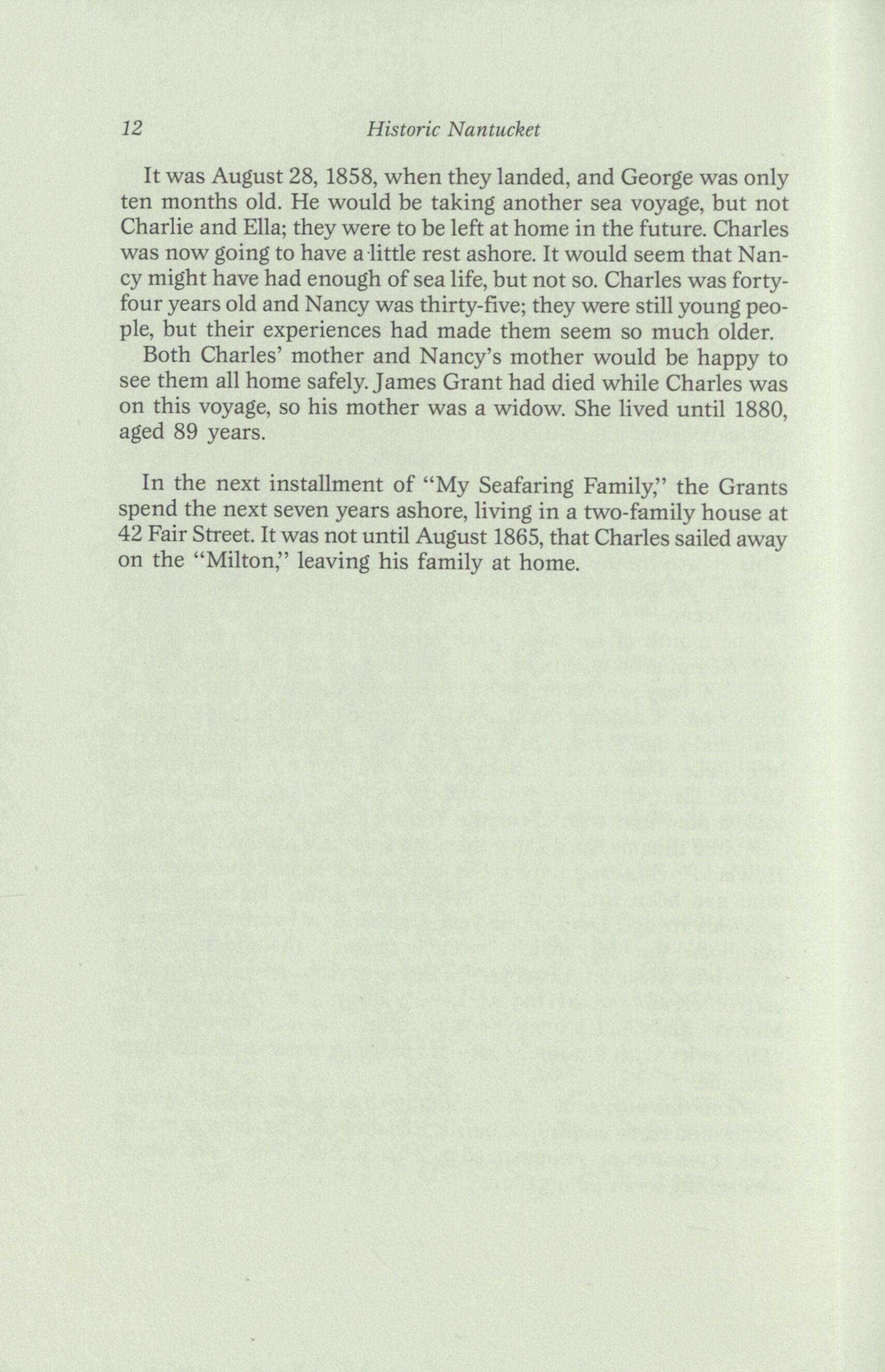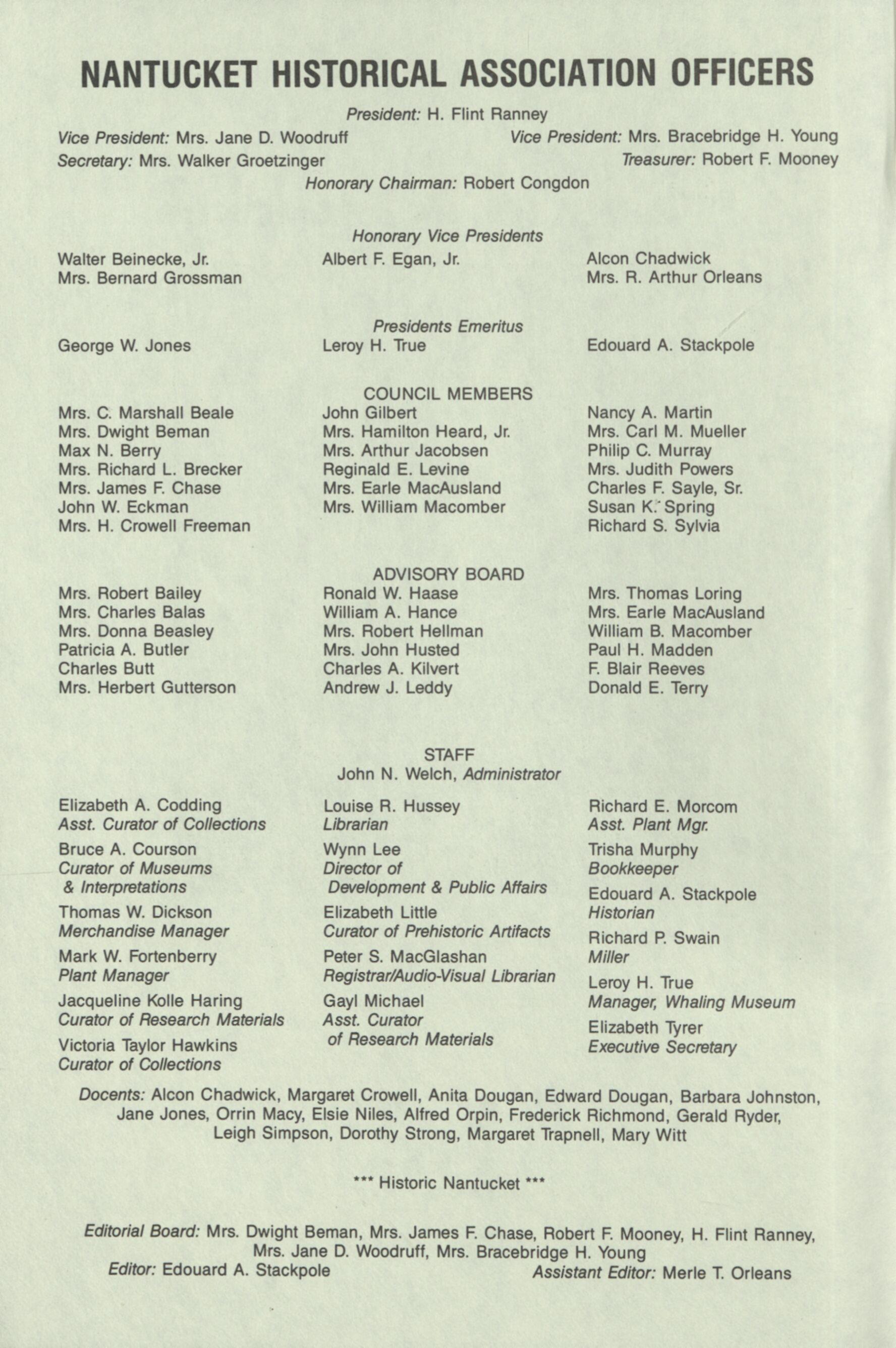
18 minute read
Vol. 37 April 1989 • No
President: H. Flint Ranney Vice President: Mrs. Jane D. Woodruff Vice President: Mrs. Bracebridge H. Young Secretary: Mrs. Walker Groetzinger Treasurer: Robert F. Mooney
Honorary Chairman: Robert Congdon
Walter Beinecke, Jr. Mrs. Bernard Grossman
George W. Jones
Mrs. C. Marshall Beale Mrs. Dwight Beman Max N. Berry Mrs. Richard L. Brecker Mrs. James F. Chase John W. Eckman Mrs. H. Crowell Freeman
Mrs. Robert Bailey Mrs. Charles Balas Mrs. Donna Beasley Patricia A. Butler Charles Butt Mrs. Herbert Gutterson
Honorary Vice Presidents Albert F. Egan, Jr.
Presidents Emeritus Leroy H. True
COUNCIL MEMBERS John Gilbert Mrs. Hamilton Heard, Jr. Mrs. Arthur Jacobsen Reginald E. Levine Mrs. Earle MacAusland Mrs. William Macomber
ADVISORY BOARD Ronald W. Haase William A. Hance Mrs. Robert Hellman Mrs. John Husted Charles A. Kilvert Andrew J. Leddy Alcon Chadwick Mrs. R. Arthur Orleans
Edouard A. Stackpole
Nancy A. Martin Mrs. Carl M. Mueller Philip C. Murray Mrs. Judith Powers Charles F. Sayle, Sr. Susan K.* Spring Richard S. Sylvia
Mrs. Thomas Loring Mrs. Earle MacAusland William B. Macomber Paul H. Madden F. Blair Reeves Donald E. Terry
Elizabeth A. Codding Asst. Curator of Collections Bruce A. Courson Curator of Museums & Interpretations Thomas W. Dickson Merchandise Manager Mark W. Fortenberry Plant Manager Jacqueline Kolle Haring Curator of Research Materials Victoria Taylor Hawkins Curator of Collections STAFF John N. Welch, Administrator
Louise R. Hussey Librarian Wynn Lee Director of Development & Public Affairs Elizabeth Little Curator of Prehistoric Artifacts Peter S. MacGlashan Registrar/Audio-Visual Librarian Gayl Michael Asst. Curator of Research Materials Richard E. Morcom Assf. Plant Mgr. Trisha Murphy Bookkeeper Edouard A. Stackpole Historian Richard P. Swain Miller Leroy H. True Manager, Whaling Museum Elizabeth Tyrer Executive Secretary
Docents: Alcon Chadwick, Margaret Crowell, Anita Dougan, Edward Dougan, Barbara Johnston, Jane Jones, Orrin Macy, Elsie Niles, Alfred Orpin, Frederick Richmond, Gerald Ryder, Leigh Simpson, Dorothy Strong, Margaret Trapnell, Mary Witt
Historic Nantucket'
Editorial Board: Mrs. Dwight Beman, Mrs. James F. Chase, Robert F. Mooney, H. Flint Ranney, Mrs. Jane D. Woodruff, Mrs. Bracebridge H. Young Editor: Edouard A. Stackpole Assistant Editor: Merle T. Orleans
Published quarterly and devoted to the preservation of Nantucket's antiquity, its famed heritage, and its illustrious past as a whaling port.
Vol. 37 April 1989
CONTENTS
• No. 2
My Seafaring Family by Nancy Grant Adams
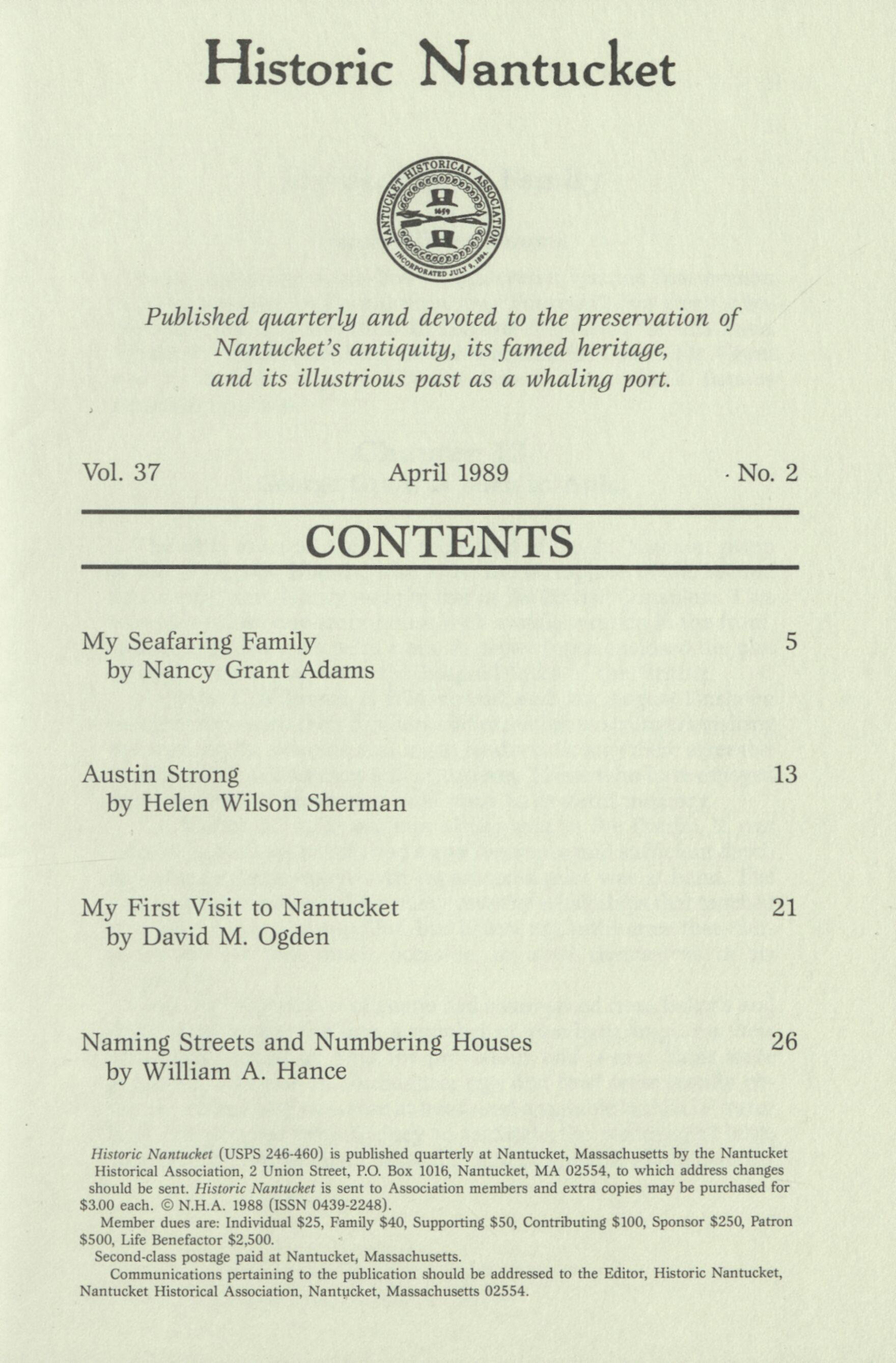
Austin Strong by Helen Wilson Sherman
13
My First Visit to Nantucket by David M. Ogden 21
Naming Streets and Numbering Houses by William A. Hance 26
Historic Nantucket (USPS 246-460) is published quarterly at Nantucket, Massachusetts by the Nantucket
Historical Association, 2 Union Street, P.O. Box 1016, Nantucket, MA 02554, to which address changes should be sent. Historic Nantucket is sent to Association members and extra copies may be purchased for $3.00 each. © N.H.A. 1988 (ISSN 0439-2248).
Member dues are: Individual $25, Family $40, Supporting $50, Contributing $100, Sponsor $250, Patron $500, Life Benefactor $2,500.
Second-class postage paid at Nantucket, Massachusetts.
Communications pertaining to the publication should be addressed to the Editor, Historic Nantucket, Nantucket Historical Association, Nantucket, Massachusetts 02554.
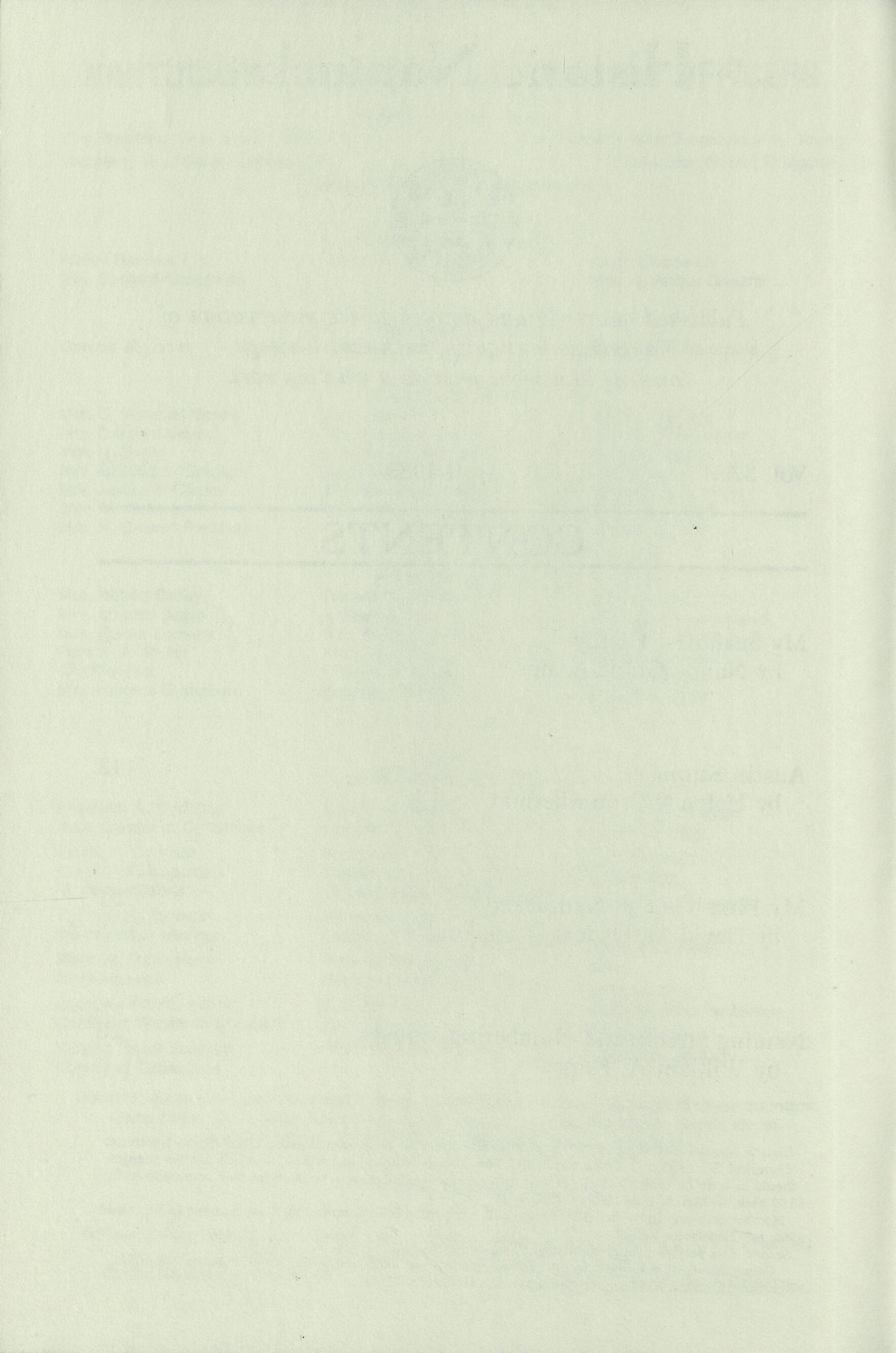
5
My Seafaring Family
by Nancy Grant Adams
Nancy Grant, an island-born Nantucketer, was the first woman to make a voyage on a whaleship, the "Potomac." Her story is being published in serial form in Historic Nantucket. In this issue, Chapter 13 reports the birth of her son, Charles Grant. Mr. Grant was to become Captain Charles Grant, Nantucket's famous whaleship captain.
Chapter 13
George Grant is born in Apia.
The little town of Apia, on the island of Upolu, Samaon group of the Navigator Islands, was to be the birthplace of the second Seafaring Grant. Nancy went to live in the British Consulate. This was a long, low, one-story house with a wide veranda in the front, and surrounded with palm trees. A picket fence enclosed the plot of land. At the rear were the hospital tents of the British.
Mr. John C. Williams, H.B.M. consul, and Mr. August Unshelm resided there with their families and extended to strangers visiting them a friendly welcome, seeking to render their stay there agreeable by many kinds of services and attentions. Those who have enjoyed their hospitality must ever hold them in grateful memory.
The harbor at Apia was one of the best in the Pacific. It was capacious, well-protected, had a good entrance and sufficient depth of water for large vessels. An experienced pilot was at hand. The port had been frequented for many years by whaleships that touched to obtain water and supplies, hut it was not until later that merchant vessels had much occasion to avail themselves of its advantages.
Since the importation of guano had commenced from Baker's and other islands near the line, a number of merchant ships, on their way home, called at Apia for provisions and water. Yams were generally to be had in abundance; pigs and fowl were readily obtained; fresh water was close at hand; and a suitable launch or water boat was ordered from Sydney to facilitate the watering of large vessels. Mr. Unshelm, an agreeable and hospitable gentleman of
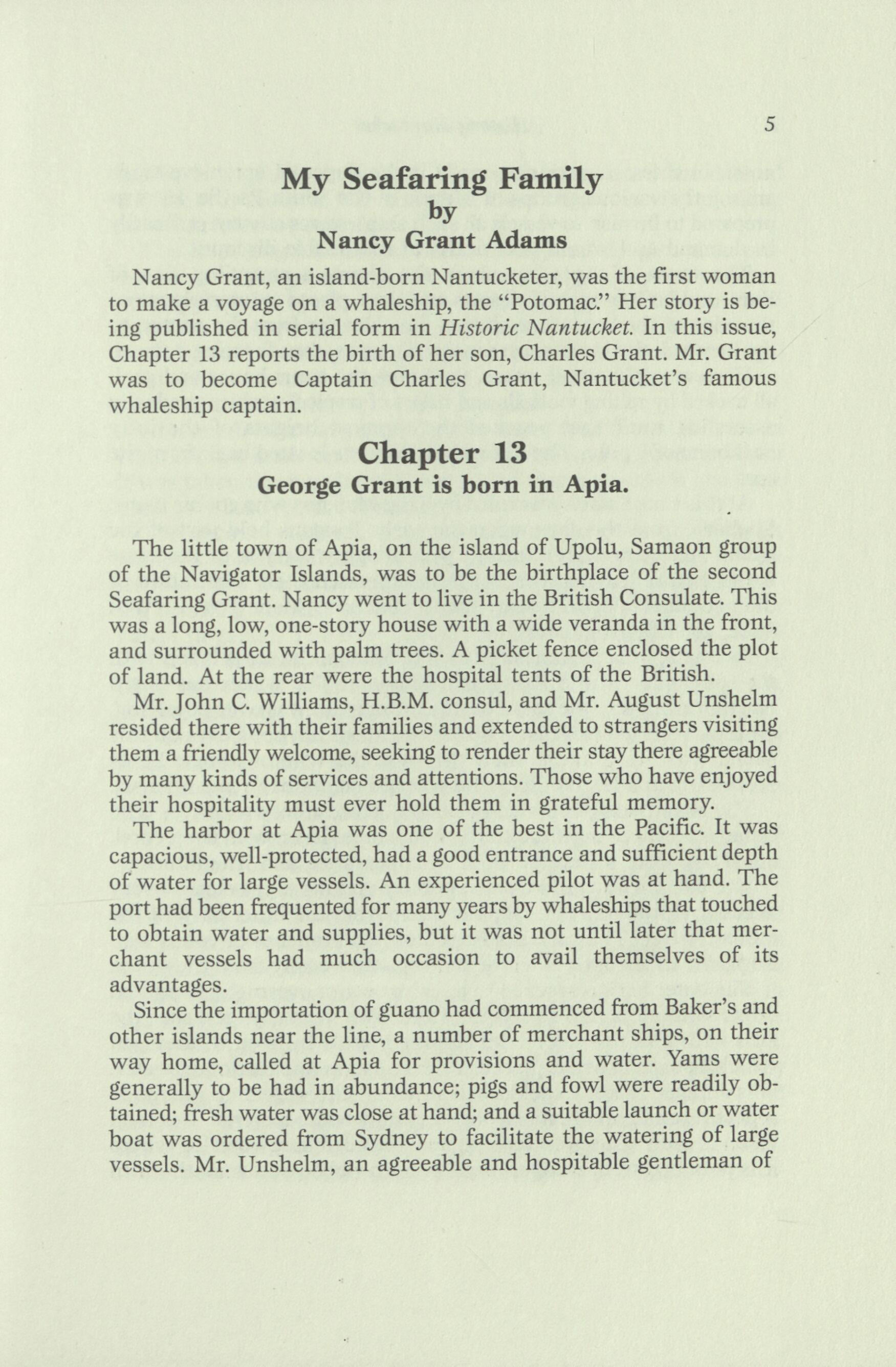
6
Historic Nantucket
much business experience, made it the depot of extensive trade among the various groups of islands in the South Pacific. He was prepared to furnish to vessels all such ship's stores as were ordinarily in demand and would take drafts at reasonable discount.
The town of Apia lay along the shore, a straggling line of European-built houses of all sorts and sizes, placed at intervals round the edge of the horseshoe-shaped bay. Not far from the center, to the leeward, the houses were in double rows, thus forming a street.
Here were the retail stores, the hotel, the court house and gaol, all backed by rolling foothills and ridges of tropical verdure, gradually ascending until they reached the topmost heights of the lofty backbone of Upolu. The native houses were located back from the sea.
At this time Samoa was ruled by King Malietoa who got his name, I believe, from the days when the early Tongans held part of the island and were driven from it by a doughty warrior of the same name. Before leaving, the Tongans expressed their admiration of their conqueror's prowess by shouting at him "Malie Toa" ~ "Well done, good fighting cock."
As one approaches these islands of Samoa, the air is laden with the spicy odor of the Frangipani blossom. The writer has heard Austin Strong say the scent of this Frangipani was over powering, even way out to sea. Austin Strong spent his boyhood days on this island with his grandmother, who was the wife of Robert Louis Stevenson, and his mother, who was her stepfather's amanuensis.
The island was populated by buxom, sturdy, brown natives who came in droves to meet the ships, their canoes laden with fruit, coral, etc. They were a fine lot, both in appearance and friendliness.
The women and girls were kept busy making tappa cloth, a very necessary product. The tappa is made from the inner bark of the mulberry tree. The bark is stripped off the branches of young saplings; the inner bark is white and separates easily from the outer.
The outer bark is steeped in the river water overnight, weighted down with stones to soften the fibre. The next day, one sees the girls sitting in the river with sloping boards in front of them on which a strip of bark is placed. With constant application of water, it is scraped with a cockleshell until all the vegetable mucus is separated and there remains only a spongy white material. It is then taken to their houses and placed on a rounded hardwood log where it is pounded with wooden beetles, both ribbed and smooth, until
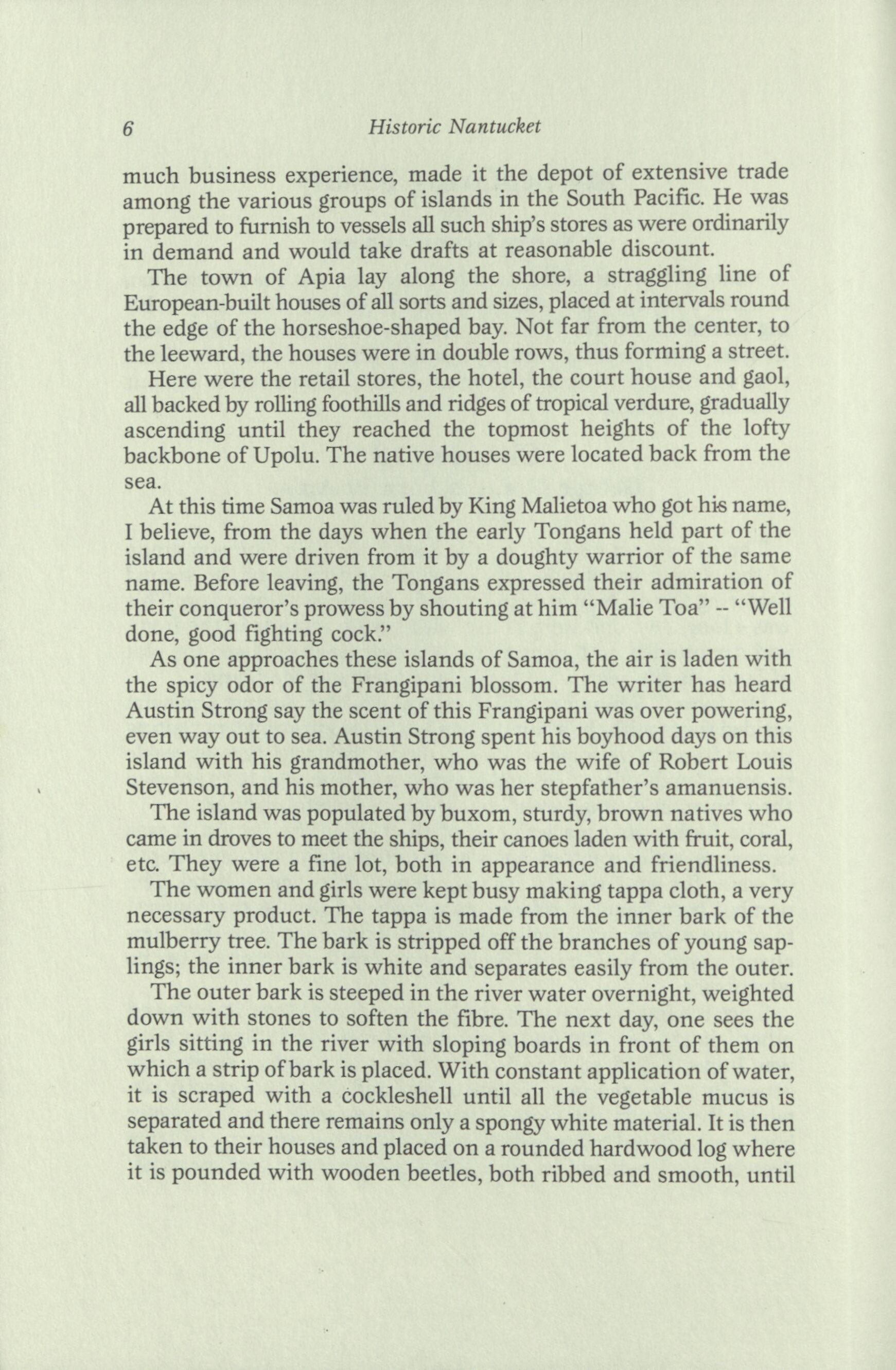
My Seafaring Family
7
the bark is greatly expanded. This is kept up until the desired thickness is secured. The sound of these beetles is very pleasing as all are used at one time.
The cloth is spread on the stones to dry, and the girls then proceed to stick the pieces together with arrow gum, layer over layer, overlapping side by side until the cloth is the proper thickness and size. It is subsequently stained with berry juice or dyes manufactured by their own ingenuity, made up in rolls and stored amongst the roof beams until needed. They made mats, clothing and curtains, etc., from this very useful material.
At a much later date, after Charles Grant had bought a home in Nantucket, a linoleum floor covering was laid in the kitchen. When it was taken up years later, it was found that tappa cloth had been used as a base for the linoleum.
The coconut was also of great value to the natives. The milk makes a delicious drink and the partially formed kernel is in a jellylike state which is very appetizing. The shell was used for making drinking vessels, water pitchers, lamps, funnels, fuel and for Panga (a game). The fibre became sennit, cordage and bed stuffing, scrub brushes, whisks for flies and medicine. The leaf was used to thatch the houses and as lining for houses, mats, baskets, combs, bedding, brooms, screens for bedrooms and other uses.
The natives sat on mats to eat a meal at the best houses, drank from coconut shells and ate from large shells.
Lotus and hibiscus blossoms were profuse. There were many ferns and sensitive plants and rubber trees.
The natives greet you with "Alofa," meaning "How do you do?" and "Tofa" for "Good-bye." They were fond of fun and sports and were great procrastinators: "Tomorrow is just as good as today." Surf riding was the main sport. The rider wades out as far as he can go on the reef, carrying a flat board about three feet long. When a suitable wave comes along, he throws himself on his chest flat on the board; and as the wave breaks over him, it carries him with a great velocity toward shore. They never tired of this sport. Another sport was pig hunting and pigeon catching.
A game they enjoyed was called Tiga-tia. This was played by throwing a light stick about four feet long as far as possible, and the one who threw the greatest length in one direction was the winner. They also loved to play cards; Euchre was their favorite game.
On March 24th, her most gracious Majesty the Queen's birth-
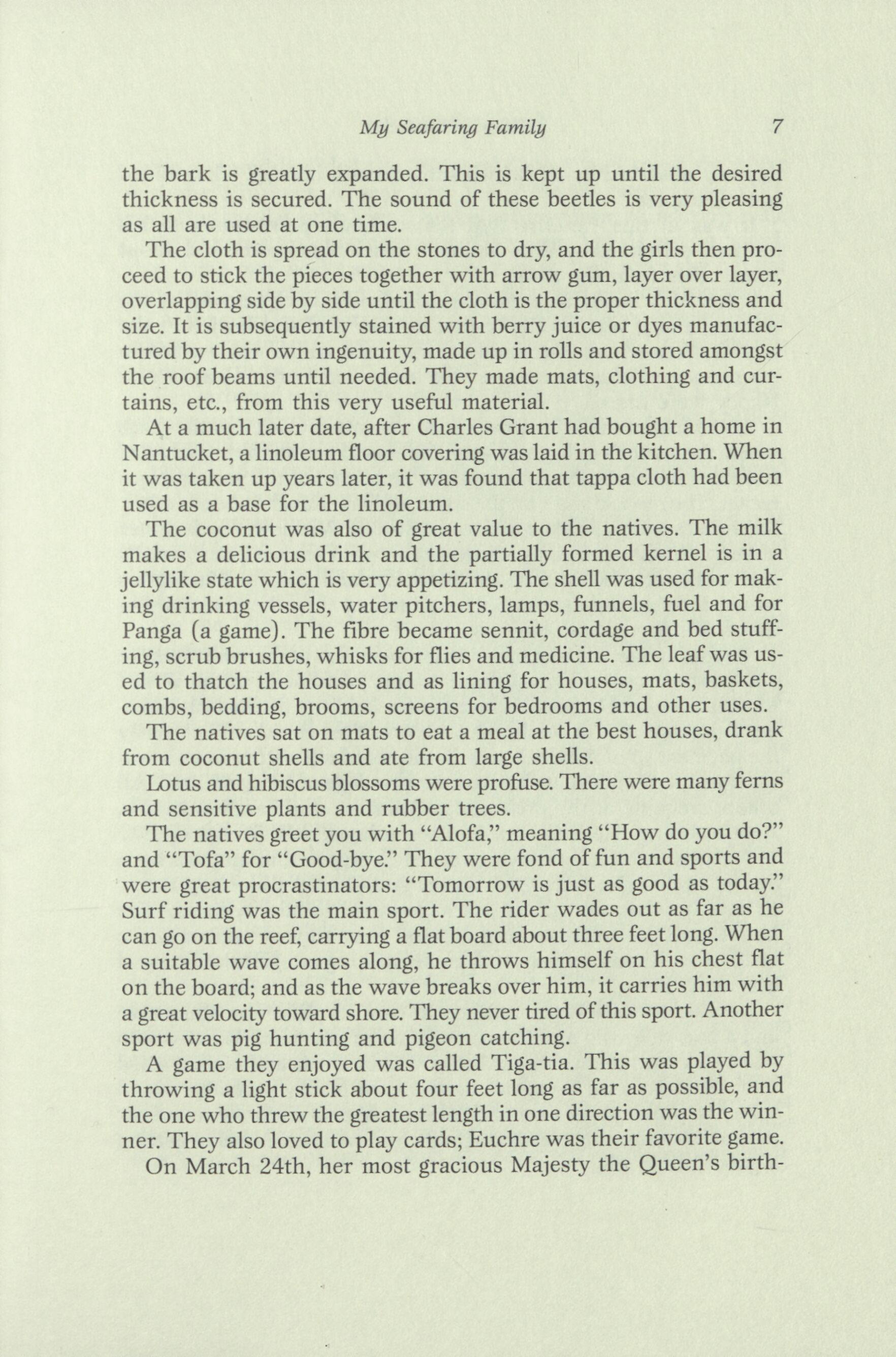
8 Historic Nantucket
day was observed by all British subjects as a holiday. They called her "Vikitoria."
It was in this Paradise that Robert Louis Stevenson and his devoted wife lived at Villa Vailima, which was up the hill about three miles from the town.
R.L.S., or "Tusitala" as he was called, was much beloved by the natives, and it was on Upolu that he died and was buried at the top Mt. Vaca where one could see the tomb which was erected in his memory. (This, of course, was many years after Charles and Nancy were there.)
At the foot of the hill where R.L.S. was later buried was the place where the writer's father was born. He was to become a very devoted friend of Austin Strong who spent a large part of the year in Nantucket. They would meet on the street and talk Kanaka to" each other. Sometimes, along would come Sarah Bunker Winslow, the daughter of Perry Winslow, who as a little girl went to sea with her parents and was dearly beloved by the New Zealand people. The stories would then accumulate rapidly, one telling the others something that had happened so long ago.
Another place the two men would meet was at the wharf where old sea stories are told in Wallace Adams' boathouse, or the Wharf Rat Club where Herbert Hunter Coffin held the distinction of being Commodore. This club was exclusive. One could not belong by the payment of money, but only if one could tell a story or had real sea blood in him. The writer has the privilege of being a "Rat." All others are gone at the present day: John M. and Sarah Winslow, Austin Strong, Herb Coffin, Wallace Adams, and George Grant.
The new little Grant baby was called George Arthur and was born on the 28th of October, 1857. Nancy and Charles were very happy to have another son. He was also destined to be a seafarer. The natives and the colonists on the island were all very excited at the birth of an American baby and came offering congratulations and bearing gifts.
Now there were three children to care for. Ella was about two and a half years old and Charlie was seven years old. What would Nancy do with them on board ship? Other wives and mothers had their children with them on the ships, so Nancy probably would solve the problems as they had done. Charles cruised the next four months after leaving Nancy at Upolu and was successful in getting a good fare of oil.
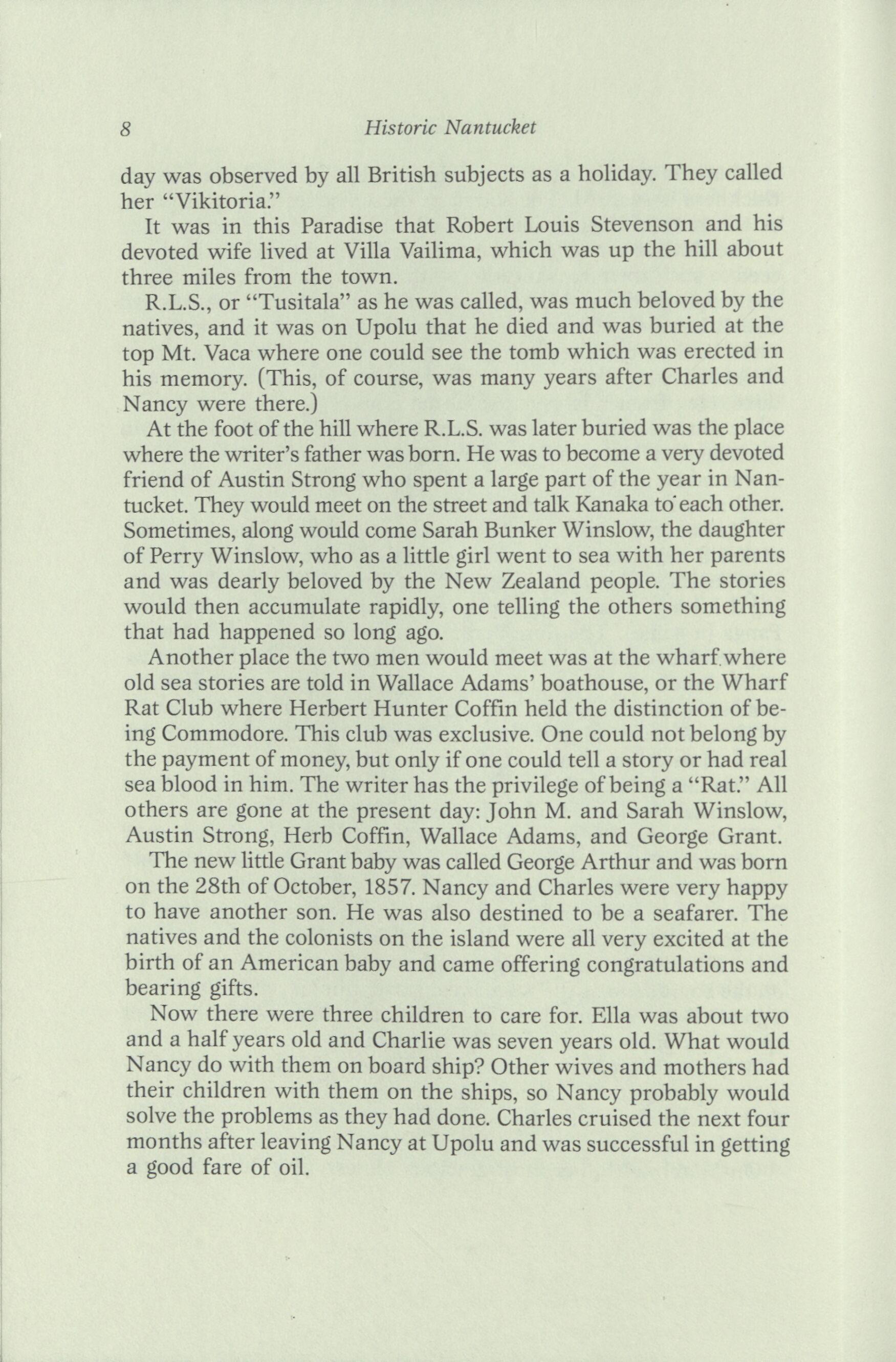
My Seafaring Family 9
He met and boarded the "Edward Carey" and spent the night with the Winslows. A week later, the Winslows returned the visit, spending the day with him. This helped him from heing too lonely.
On October 3rd, his log states, "Two small birds are on board; they came two weeks ago. On their arrival, they were shy but got over that, and they ran around the deck and ate cockroaches."
On the day Georgie was born, they were beating up toward Upolu and on November 5, they steered into the harbor at Upolu and anchored in three fathoms of water.
The larboard watch was on liberty and the third mate and boatsteerer were discharged, also one foremast hand. A third officer and two foremast hands were shipped.
On the 15th, they found a man stowed away on the ship, ordered him into a boat and landed him on shore.
In the meantime, Charles had become acquainted with his new son and found Nancy recuperating very nicely. Thanks to the good care given her by her kind friends on the island, she was happy and in good health.
On the 17th of November, 1857, the log reads, "All hands were employed in getting ready for the sea, getting off yams, bananas, wood, pigs and babies and various other articles." In the years to come, this log book would be in the Whaling Museum at Nantucket, and George would show it to the visitors at the museum and run his fingers over the above entry. As he reached "and babies," he would say, "That is me." He wore the page down so much telling this to visitors that, finally, the log had to be put away for fear it would get worn out.
The day that the Grant family left was a very eventful time. Charles led the way holding a satchel in one hand and Ella by the other. Charlie followed with bundles and bags, then Nancy with more bundles. At last, proud as she could be to be granted the privilege, came a native woman carrying the new three-week-old baby George, wrapped in a banana leaf. Following them was a procession of natives all carrying bags and bundles. A day to be remembered, and the story was told many, many times in the years to come by George who lived to tell his listeners, "Yes, I was born in Samoa and went to sea for the first time when I was three weeks old and was wrapped in a banana leaf." One of his listeners was so amazed at his story that she said to him, "Born in Samoa? Why? Was your mother there?" "Well, she certainly was," George replied.
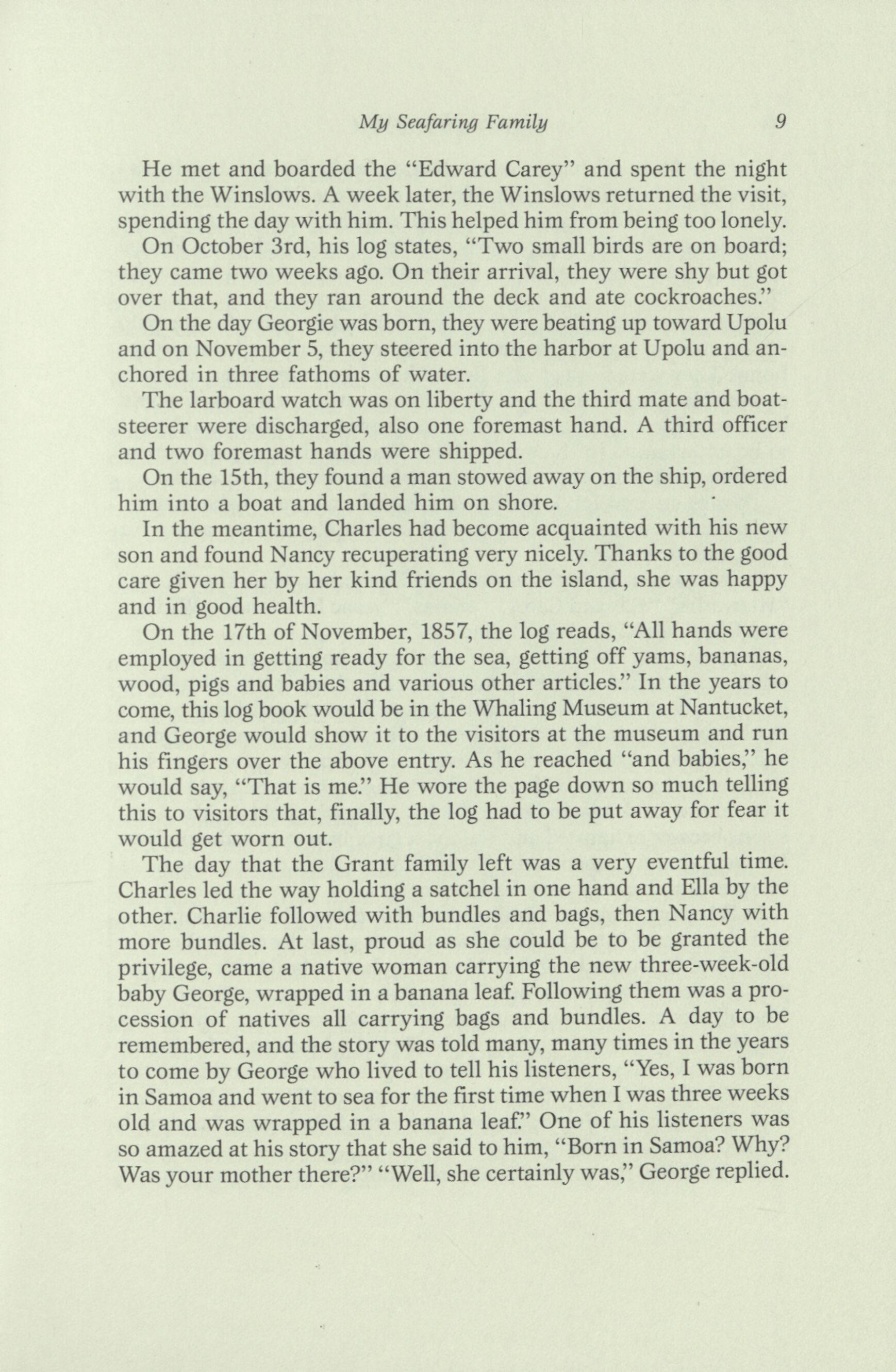
10 Historic Nantucket
On the 20th, all hands were aboard, ready for sea, but it was several days before they got under way. On the 24th, the ship was crowded with ladies, some European and the greater part natives of Samoa; and there were canoes alongside most of the day, loaded with males and females of the Samoan tribe to say good-bye to the "Mohawk."
Nancy was certainly kept busy and if it had not been for the help of the men on board, she never could have weathered the voyage home. They were fond of Charlie and kept him entertained as much as possible. On stormy days, the problems were many as it would be impossible to go up on deck, and Charlie and Ella would have to be entertained in the small cabin. Georgie slept a good part of the time; lulled by the rock of the ship, he needed no cradle.
Charles steered for Lord Howe's Island and werrt ashore there for potatoes, yams and onions, and stood off and on trading for pork and vegetables.
Ships spoken during the month of December were: the "King," "Hiawatha," "Edward Carey," "Midas," "Isaac Howland," "William and Eliza" and "Sophia Thompson."
On January 7, 1858, they had a sad time; boats were down after whales and struck and killed one, but the third mate, John Armstrong, a black man from Nantucket, fell overboard from one of the boats and not knowing how to swim, he was about to drown before he could be recovered. Two men jumped in after him; but the boat had a sail on with a stiff breeze and a heavy sea and before it could row back to windward, the two men who held up Mr. Armstrong became exhausted and had to let go of him to save themselves. He went down immediately. Everything in their power was done to save him, but his time had come.
In February, they were boiling out oil one day when the pot burst and the oil ran into the fire. Two barrels were lost, but the ship was saved from catching fire. Now they had to boil with only one pot. They got fifty barrels, but Charles was anxious to get forty more. The oil was stored down and another pot set in the try works. On the 19th, they came to anchor in the Bay of Islands to fit for home. On the 23rd, they took on for freight eighty barrels of oil from the ship "Swift" and eighty from the "James Arnold," both of New Bedford. The next day, they hauled alongside the "Shepardess" and took on 180 barrels for freight.
On the 14th, the carpenter deserted, but he was taken again and
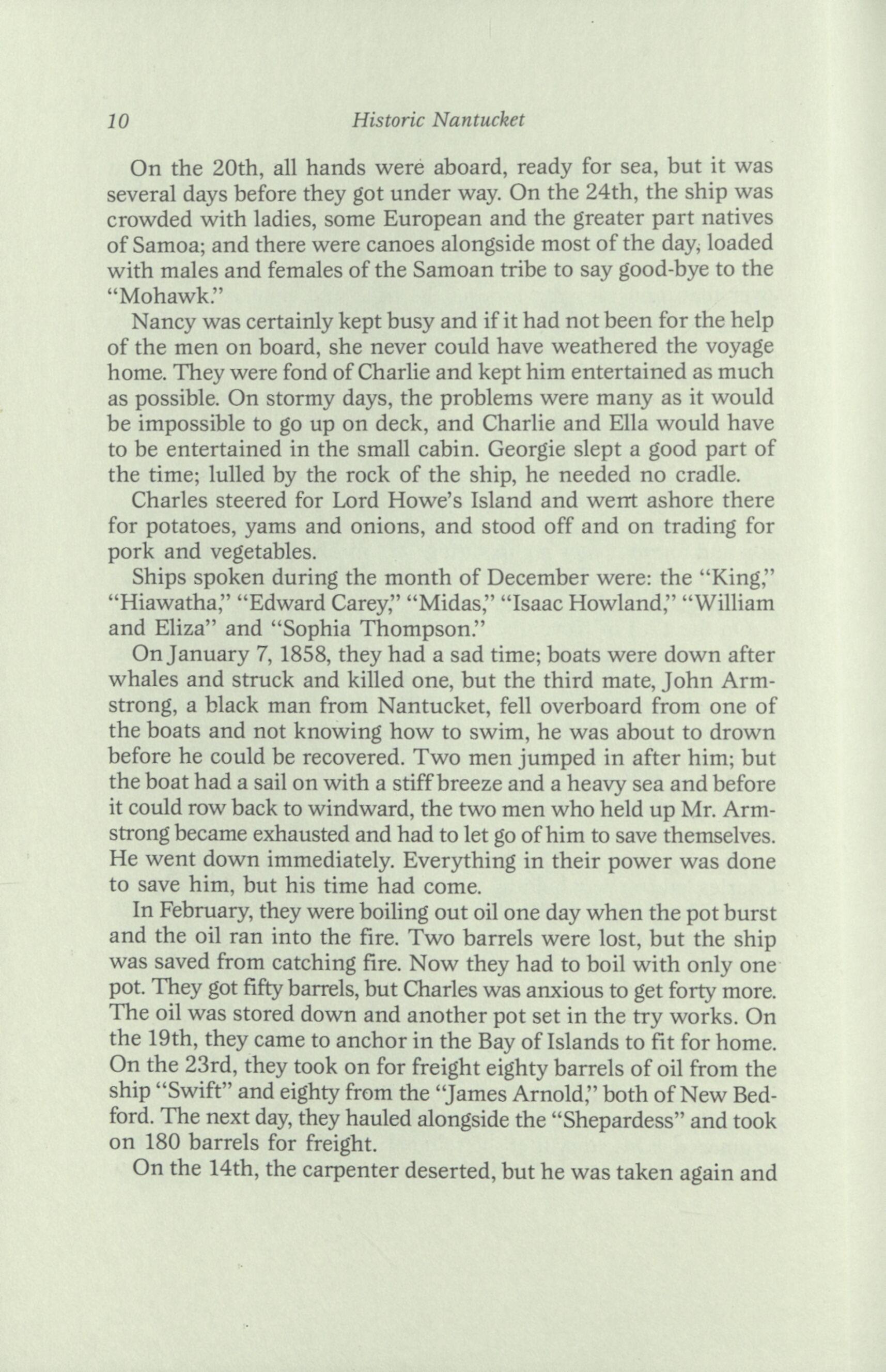
My Seafaring Family
11
put in irons for twelve hours.
On March 16, they got under way and steered out of the bay. All during April, they saw more ships than whales.
A very bad storm did a lot of damage on May 24th. Both starboard and larboard boats were smashed to pieces. One of the bearers broke which brought down two boats from overhead, stove one of them, carried away two davits, seven cranes and lines. All hands were called on deck to clear away the debris and bail out the water from the cabin and staterooms. They had only one boat left now.
Poor Nancy, how she must have suffered with water in the cabin, seasickness and all the inconveniences of trying to care for the three children in a small space. For the next seven days, all hands were busy repairing boats. They found a cask of flour damaged and threw that overboard; however, they were homeward bound and by June 16, Cape Horn was sighted. They passed it within twenty-five miles. This return by the Horn made their voyage "Round the World" as they had gone out via the Cape of Good Hope through the Indian Ocean.
The month of July was taken up painting the ship inside and out, cleaning up generally and polishing everything in sight. On the 15th, they saw several vessels off Cape Augustine and Pernambuco. Charles ordered the ship to lay off and on while they got fresh fruit and small stores. On August 21, they spoke and boarded the brig "Belle of the West" of Boston, five days out bound for Baltimore. On the 22nd, they took down the try works, sighted Block Island, took a pilot and steered for the Nantucket bar.
At one time in April 1858, they had spoken with the ship "Isaac Howland" whose master was Captain Reuben Hobbs, the same man who had been first mate with Charles on the "Potomac" on a previous voyage. Later in the year, Captain Hobbs spent the evening aboard the "Mohawk." On one occasion in the Phoenix group of islands, while on this voyage, a group of ships met and gammed each other; all hove to. They were the "Edward Carey," "Commander Morris" and the "Mohawk." A reunion was held on board the "Mohawk" with a dinner party of roast pig, plum duff and pumpkin pie.
When this voyage was over, Captain Charles Grant and his wife Nancy and three children, Charlie, Ella and Georgie, landed on the dock at Nantucket, accompanied by 2,050 barrels of sperm oil which was selling at $1.50 a gallon.
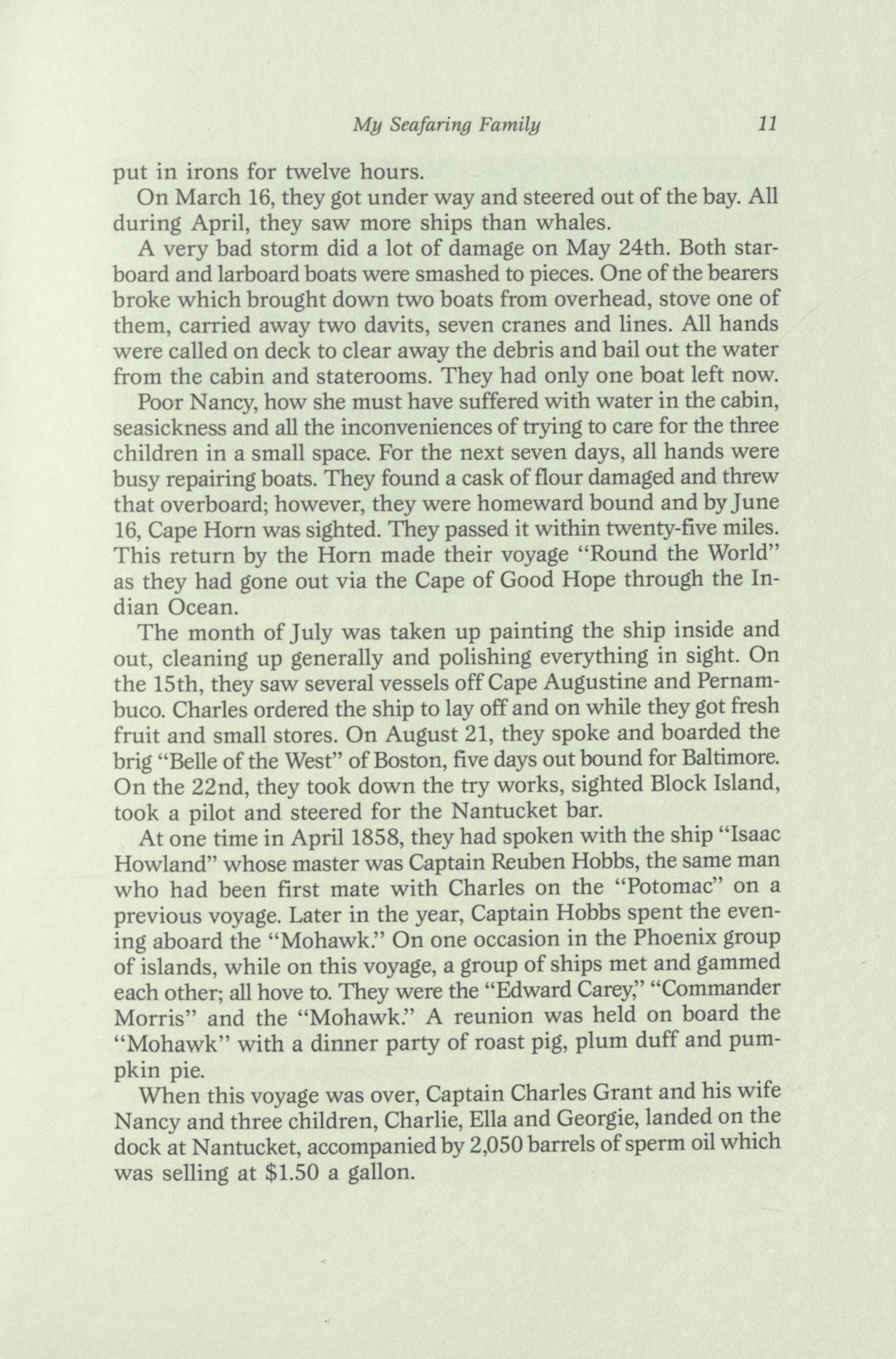
12 Historic Nantucket
It was August 28, 1858, when they landed, and George was only ten months old. He would be taking another sea voyage, but not Charlie and Ella; they were to be left at home in the future. Charles was now going to have a little rest ashore. It would seem that Nancy might have had enough of sea life, but not so. Charles was fortyfour years old and Nancy was thirty-five; they were still young people, but their experiences had made them seem so much older.
Both Charles' mother and Nancy's mother would be happy to see them all home safely. James Grant had died while Charles was on this voyage, so his mother was a widow. She lived until 1880, aged 89 years.
In the next installment of "My Seafaring Family," the Grants spend the next seven years ashore, living in a two-family house at 42 Fair Street. It was not until August 1865, that Charles sailed away on the "Milton," leaving his family at home.
